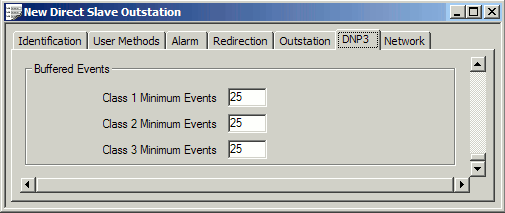Use the fields within the Buffered Events section of the DNP3 tab to define the minimum number of buffered events that are required in order for ClearSCADA to send a unsolicited message to the DNP3 master. When ClearSCADA generates an unsolicited response, it sends the buffered events (of all enabled event classes) for the DNP3 Slave outstation to the DNP3 master.

- Class n Minimum Events—Specify the number of Class 1, Class 2, and Class 3 events that have to accumulate before the DNP3 slave outstation sends an unsolicited message containing event data, to the DNP3 master.
-
Example:
A DNP3 Slave outstation is configured to send unsolicited messages to its master. The outstation has this configuration:
Class 1 Minimum Events: 10
Event Notification Delay: 10 secondsThe DNP3 Slave outstation has nine Class 1 events in its buffer.
A tenth Class 1 event is added to the DNP3 Slave outstation’s event buffer.
Seven seconds after the tenth event, an eleventh Class 1 event is added to the DNP3 Slave outstation’s event buffer.
Ten seconds after the tenth event was added the DNP3 Slave outstation’s event buffer, ClearSCADA will send an unsolicited message to the DNP3 master. This message will contain eleven events.
After another two seconds, a twelfth Class 1 event is added to the DNP3 Slave outstation’s event buffer.
After the DNP3 master responds to the slave’s unsolicited message, ClearSCADA will remove the first eleven events from the DNP3 Slave outstation’s event buffer, leaving one event in the buffer (the event that occurred after the outstation sent the unsolicited message to the DNP3 master).
(The Event Notification Delay field is near the top of the DNP3 tab—for information, see Configure the General DNP3 Properties.)